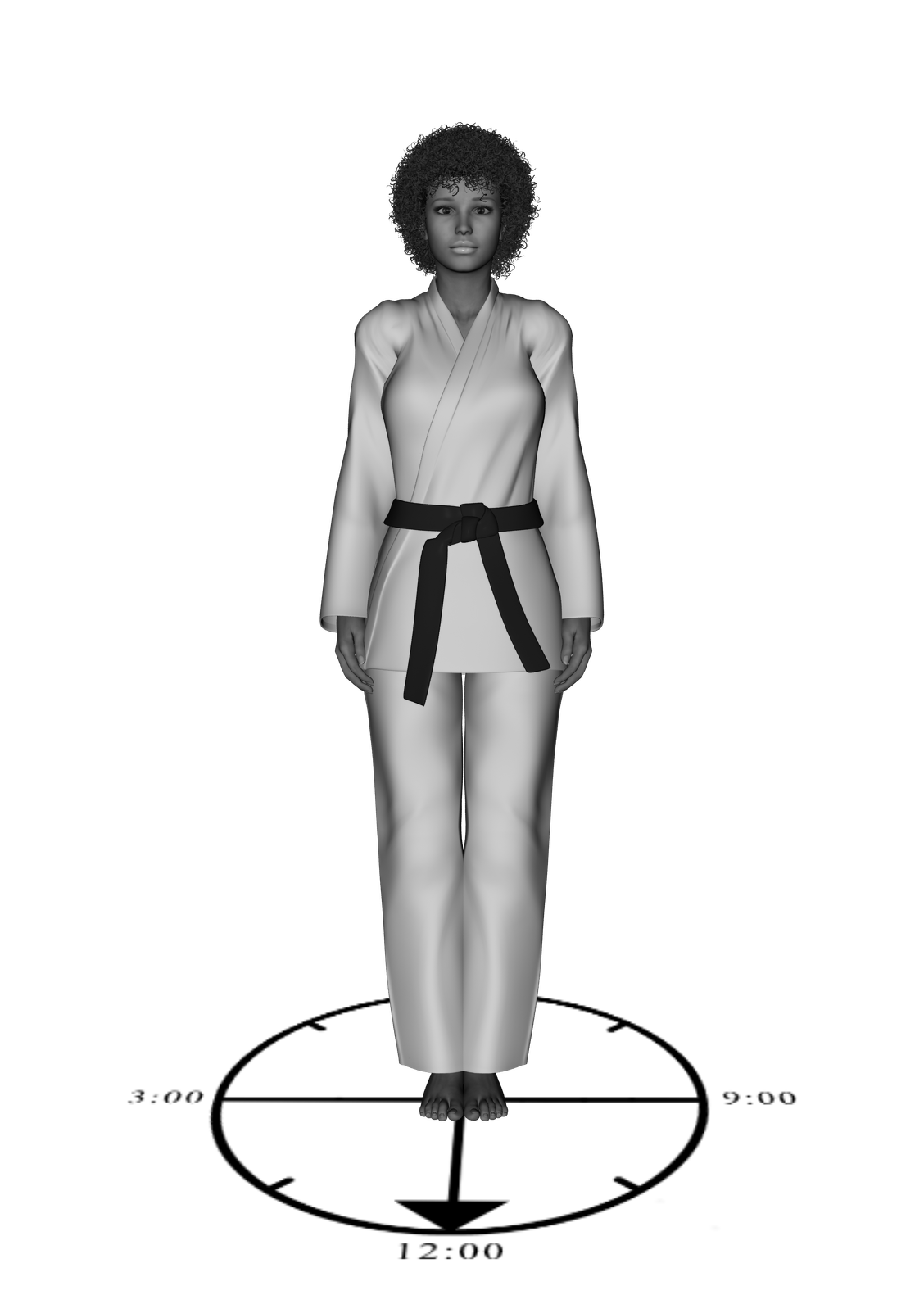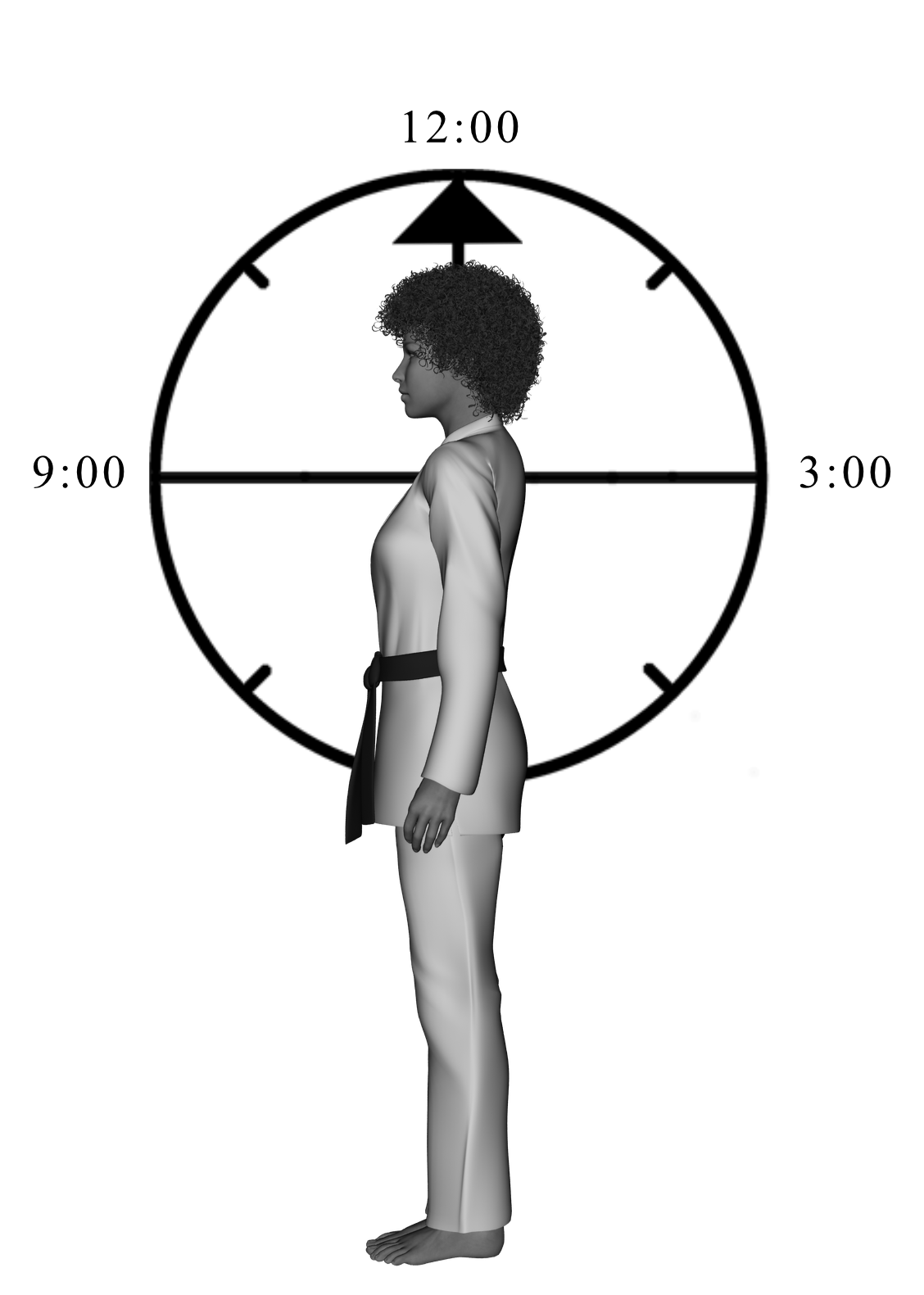Definition:
An idiom describing a method of representing direction and position through the visualization of the practitioner being inside and at the center of an analog clock.
Usage / Purpose:
In it's three (3) dimensional form, the clock principle can be described as visualizing a practitioner being at the center of nine (9) different clock faces oriented horizontally, vertically, and diagonally with each passing through the practitioner's body. From the center of the planes the practitioner can easily specify direction and position in the surrounding environment using time on one of the clock's faces as a reference point. This three (3) dimensional clock representation is directly tied to the three (3) dimensional Universal pattern with each plane of the pattern represented by a clock face.
But, the most common and simplest way to visualize the clock is to imagine the practitioner standing at the center of a clock laying flat (horizontally) on the ground, with the clock face pointing upward, and the clock surrounding them - with 12:00 directly forward, 6:00 directly behind, 3:00 to the right and 9:00 to the left. To expand upon that a little further, a vertical representation of the the clock, cutting the practitioner down the center-line, vertically, would place 12:00 directly upward, 6:00 directly downward, 3:00 directly behind and 9:00 directly forward (this is of course assuming the vertical clock face is oriented to the practitioner's left - otherwise, 3:00 and 9:00 would be switched).
 (H) - Horizontal Clock |
 (V) - Vertical Clock |
In the "Execution of Short Form Three" section of this book, all text that specifies direction using the Clock principle, and also has an "H" or a "V" after the time designation. The "H" representing a horizontal clock and the "V" representing a vertical clock. This designation is done to help the reader better visualize the intended direction specified in the text. Otherwise, it is possible that by visualizing the incorrect plane the wrong direction may be interpreted. For instance 12:00 on the horizontal plane means directly ahead, where 12:00 on the vertical plane means straight above and 9:00 means directly ahead. Also, 6:00 on the horizontal plane means directly behind, where on the vertical plane it means directly below and 3:00 means directly behind (again assuming a left oriented vertical clock face).
So, why two (2) clocks, horizontal and vertical, and not just one (1)? Because some directions are more precisely described using both planes in conjunction with one another. For example, 12:00H and 9:00V is a different direction from 12:00H and 10:30V. One being from straight ahead and parallel to the floor and the other being from straight ahead, but approaching on a downward diagonal path. Using this approach, it is possible to describe direction and position more accurately and without misinterpretation (while also forcing a specific oriented vertical clock face - without assumption).
The disadvantage of using nine (9) clocks in the three (3) dimensional model is that in order to be precise one must first specify which of the nine (9) clock planes is being used and then the time on the clock (and usually the orientation of the face). And, furthermore, one must first be able to agree upon and then remember the numbering of each of the nine (9) planes, which can be difficult. In contrast, It is much easier to use the two (2) clock planes that are easiest to remember (horizontal and vertical) in conjunction with one another to come to the exact same result.
In order to visualize each of the nine (9) clocks in relation to the practitioner, start with the standard clock visualization of the practitioner standing at the center of the clock and follow each of the following steps to achieve each plane:
1)raise clock directly upward to center of body (parallel to ground)
2)from #1, tilt upward from 12:00 90-degrees (perpendicular to ground)
3)from #1, rotate 90-degrees clockwise and then tilt upward from 12:00 90-degrees (perpendicular to ground)
4)from #1, rotate 45-degrees clockwise and then tilt upward from 12:00 90-degrees (perpendicular to ground)
5)from #1, rotate 45-degrees counter-clockwise and then tilt upward from 12:00 90-degrees (perpendicular to ground)
6)from #1, tilt upward from 12:00 45-degrees (diagonal to ground)
7)from #1, rotate 180-degrees and then tilt upward from 12:00 45-degrees (diagonal to ground)
8)from #1, rotate 90-degrees clockwise and then tilt upward from 12:00 45-degrees (diagonal to ground)
9)from #1, rotate 90-degrees counter-clockwise and then tilt upward from 12:00 45-degrees (diagonal to ground)
For further research, the clock principle can be tied directly and has a close relationship with the following other elements of American Kenpo - the Zone Concept of Directional Movement, Directional Zone principle, the Universal pattern, the Crest and the eight (8) major angles of attack, defense and balance. Further reading into these subjects can be found by referring to the Infinite Insights Series - Book 4 - Mental and Physical Constituents.